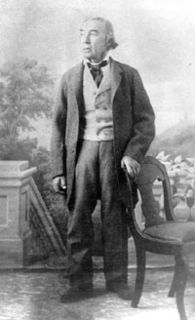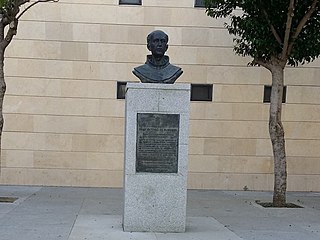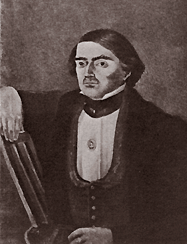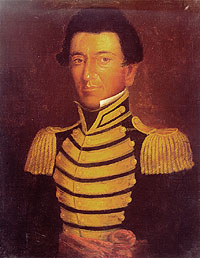 W
WJames Elijah Brown Austin was an American settler and brother of empresario Stephen F. Austin, "The Father of Texas." Counted also as one of the Old Three Hundred, he is listed in Spanish and Mexican records as "Santiago E.B. Austin". James and Stephen F. Austin are both brothers of Emily Margaret Brown Austin.
 W
WJosé María Jesús Carbajal (1809–1874) was a Tejano who was rejected by the Anglos after the Battle of San Jacinto and had to leave Texas. He then became a Mexican revolutionary, who opposed the Centralist government installed by Antonio López de Santa Anna. Carbajal was a direct descendant of Andres Hernandez and Juana de Hoyos (1709-?) (m.1729) of the settling Spanish soldier's founders of Villa de Bejar in 1718 and Canary Islands settlers who immigrated to San Antonio, Texas in the 18th Century. As a teenager in San Antonio, he was mentored by Stephen F. Austin and came under the spiritual guidance of Alexander Campbell while attending school in Virginia. He was a surveyor by trade and a politician as a result of historical events. Carbajal married into the influential De Leon family of Victoria, Texas. He called himself "a true Mexican" whose allegiance lay with the people of Mexico. He turned his back on the Republic of Texas after his land and that of many other Tejanos were confiscated by the liberal Rebels. He moved to Mexico, where he conducted guerrilla warfare against Mexican military forces. Carbajal was active in the establishment of the Republic of the Rio Grande and made an unsuccessful attempt at establishing the break-away Republic of Sierra Madre. Indicted twice in the United States for his activities, Carbajal was never convicted in a court of law. He was an early supporter of Benito Juárez and was appointed the military governor of Tamaulipas.
 W
WBenoît Chassériau was a French diplomat, French spy and Minister of the Interior of Cartagena, Colombia, comrade in arms of Simón Bolívar. He was the father of the artist Théodore Chassériau.
 W
WMartín Perfecto de Cos was a Mexican Army general and politician during the mid-19th century. Born in Veracruz, the son of an attorney, he became an army cadet at the age of 20, a lieutenant in 1821, and a brigadier general in 1833.
 W
WFrancisco Ignacio Elizondo Villarreal,, was a royalist military officer during the Mexican war of independence against Spain. He is mostly known for his capture of insurgent leaders Miguel Hidalgo, Ignacio Allende, José Mariano Jiménez, and Juan Aldama at the Wells of Baján, Coahuila in 1811. Initially a supporter of Mexican independence who converted to the royalist cause, Elizondo is sometimes compared to the American Benedict Arnold. In 1813, after a successful campaign against rebel armies he was assassinated by one of his junior officers.
 W
WManuel Flores served as a volunteer in the Texas army in 1835–1838. Fighting and commanding, he rose through the ranks to reach sergeant status during the fight for Texas independence and was commissioned a captain during the Republic years.
 W
WLouis Antoine Juchereau de St. Denis was a French-Canadian soldier and explorer best known for his exploration and development of the Louisiana and Spanish Texas regions. He commanded a small garrison at Fort de la Boulaye on the lower Mississippi River, built in 1700, and founded Fort St Jean Baptiste de Natchitoches in northern La Louisiane, as they called the French colony.
 W
WFrançois Antoine "Charles" Lallemand was a French general who served Napoleon I of France, tried to found a colony in what is now Texas, and finally returned to France to serve as governor of Corsica.
 W
WMartín De León (1765–1833) was a rancher and wealthy Mexican empresario in Texas who was descended from Spanish aristocracy. He was the patriarch of one of the prominent founding families of early Texas. De León and his wife Patricia de la Garza established De León's Colony, the only predominantly Mexican colony in Texas. They founded the town of Villa de Nuestra Señora de Guadalupe Victoria Nombre de Jesús on the Guadalupe River. The name referred both to the river and to Mexico's president Guadalupe Victoria.
 W
WJosé Toribio Losoya, was a former Mexican soldier, a Texian military participant in the Siege of Bexar and Battle of the Alamo defender.
 W
WJosé Antonio Menchaca was an American soldier and politician who fought in the Texas Revolution and was recognized by a Joint Resolution of the Republic of Texas on December 22, 1838. Following the war, Menchaca served on the city council of San Antonio, Texas. He later commanded militia troops and helped defend the town from a Mexican invasion by General Adrian Woll in 1842.
 W
WJosé Antonio Navarro was a Texas statesman, revolutionary, rancher, and merchant. The son of Ángel Navarro and Josefa María Ruiz y Peña, he was born into a distinguished noble family at San Antonio de Béxar in the Viceroyalty of New Spain. His uncle was José Francisco Ruiz and his brother-in-law was Juan Martín de Veramendi.
 W
WFelipe Enrique Neri was a Dutch businessman and land owner known for his money in Anglo-American settlement of Texas.
 W
WAntonio de San Buenaventura y Olivares or simply Fray Antonio de Olivares was a Spanish Franciscan who officiated at the first Catholic Mass celebrated in Texas, and he was known for contributing to the founding of San Antonio and to the prior exploration of the area.
 W
WAlonso Álvarez de Pineda was a Spanish Conquistador and cartographer who was first in Texas history. In 1519, he led several expeditions to map the westernmost coastlines of the Gulf of Mexico, from the Yucatán Peninsula to the Pánuco River, just mapped parts of Florida, which he believed to be an island. Antón de Alaminos' exploration eliminated the western areas as being the site of the passage, leaving the land between the Pánuco River and Florida to be mapped.
 W
WJosé Francisco "Francis" Ruiz was a soldier, educator, politician, Republic of Texas Senator, and revolutionary.
 W
WTomás Sánchez de la Barrera was a veteran Spanish captain who founded Laredo, Texas, United States, and Nuevo Laredo, Tamaulipas, Mexico, the only town in the Nuevo Santander province.
 W
WJuan Nepomuceno Seguín was a Spanish-Tejano political and military figure of the Texas Revolution who helped to establish the independence of Texas. Numerous places and institutions are named in his honor, including the county seat of Seguin in Guadalupe County, the Juan N. Seguin Memorial Interchange in Houston, Juan Seguin Monument in Seguin, World War II Liberty Ship SS Juan N. Seguin, Seguin High School in Arlington.
 W
WPedro Romero de Terreros (1710–1781), the first Count of Regla, was a mining magnate and philanthropist in 18th century Mexico.
 W
WThe Texas Ranger Division, commonly called the Texas Rangers and also known as "Los Diablos Tejanos"—"the Texan Devils", is a U.S. statewide investigative law enforcement agency with statewide jurisdiction in Texas, based in the capital city of Austin. Over the years, the Texas Rangers have investigated crimes ranging from murder to political corruption, acted in riot control and as detectives, protected the governor of Texas, tracked down fugitives, and functioned as a paramilitary force at the service of both the Republic (1836–1845) and the state of Texas.
 W
WManuel Lorenzo Justiniano de Zavala y Sanchez, known simply as Lorenzo de Zavala, was a Mexican and later Tejano physician, politician, diplomat and author. Born in Yucatán under Spanish rule, he was closely involved in drafting the constitution for the First Federal Republic of Mexico in 1824 after Mexico won independence from Spain. Years later, through a remarkable series of events, he also helped in drafting a constitution for Mexico's rebellious enemy at the time, the Republic of Texas, to secure independence from Mexico in 1836. Zavala was said to have had a keen intellect and was fluent in multiple languages.